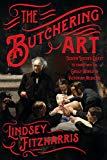Highlighted titles from the newest additions to the HSL Collection. A full list of new titles can be found online.
Handbook for principles and practice of gynecologic oncology, edited by Douglas A. Levine, et al.
|
Online |
The butchering art: Joseph Lister’s quest to transform the grisly world of Victorian medicine, by Lindsey Fitzharris.
“In The Butchering Art, the historian Lindsey Fitzharris reveals the shocking world of nineteenth-century surgery on the eve of profound transformation. She conjures up early operating theaters–no place for the squeamish–and surgeons, working before anesthesia, who were lauded for their speed and brute strength. These medical pioneers knew that the aftermath of surgery was often more dangerous than their patients’ afflictions, and they were baffled by the persistent infections that kept mortality rates stubbornly high. At a time when surgery couldn’t have been more hazardous, an unlikely figure stepped forward: a young, melancholy Quaker surgeon named Joseph Lister, who would solve the deadly riddle and change the course of history. Fitzharris dramatically recounts Lister’s discoveries in gripping detail, culminating in his audacious claim that germs were the source of all infection–and could be countered by antiseptics. Focusing on the tumultuous period from 1850 to 1875, she introduces us to Lister and his contemporaries–some of them brilliant, some outright criminal–and takes us through the grimy medical schools and dreary hospitals where they learned their art, the deadhouses where they studied anatomy, and the graveyards they occasionally ransacked for cadavers.”– Publisher’s description |
WZ100 L75 F555 2017 |
Nutrition and integrative medicine: a primer for clinicians, edited by Aruna Bakhru with contributions from NYMC author Yoshiaki Omura.
“While medical professionals continue to practice traditional allopathic medicine, the public has turned toward nutritional and integrative medical therapies, especially for addressing the proliferation of chronic diseases. Written by leaders in the academic and scientific world, Nutrition and Integrative Medicine: A Primer for Clinicians presents various modalities to help restore health. This book provides users with a guide to evaluating and recommending nutritional and integrative therapies.”– Amazon |
WB113 N974 2019 |
US Army physician assistant handbook, by
“The book describes the myriad of positions and organizations in which PA’s play in leadership roles and patient care. The book will also cover PA education, certification, continuing training, and career progression. Topics include; the Inter-service PA Program, assignments at the White House and the Old Guard (3rd US Infantry Regiment), roles in research and recruiting, as well as the PA’s role in emergency medicine, aeromedical evacuation, clinical care, surgery, and occupational health.”– Publisher’s description |
Online |
Medicine at Michigan: a history of the University of Michigan Medical School at the bicentennial, by Dea H. Boster and Joel D. Howell.
“A trailblazer in American medical education since 1850, the Medical School at the University of Michigan was the first program in the United States to own and operate its own hospital and the earliest major medical school to admit women. In the late nineteenth century, the School emerged as a frontrunner in modern scientific medical education in the United States, and one of the first in the nation to implement both required clinical clerkships and laboratory science as part of their curriculum, including the first full laboratory course in bacteriology. Decades later, the Medical School remained at the vanguard of medical education by increasing its focus on research, and these efforts resulted in world-changing breakthroughs such as field-testing the first safe polio vaccine, proposing a genetic mechanism for sickle cell anemia, inventing the fiber-optic endoscope, and cloning the gene responsible for cystic fibrosis. The Medical School’s history is not without its growing pains: alongside top-tier education and incredible innovation came times of stress with the broader University and Ann Arbor communities, complex expectations and realities for student diversity, and many controversies over curriculum and methodology. Medicine at Michigan explores how the School has dealt with changes in medical science, practice, and social climates over the past 150 years. This book will appeal to readers interested in the history of medicine as well as current and former medical faculty members, students, and employees of the University of Michigan Medical School.” — Publisher’s description |
W19 AM5 B747m 2017 |





